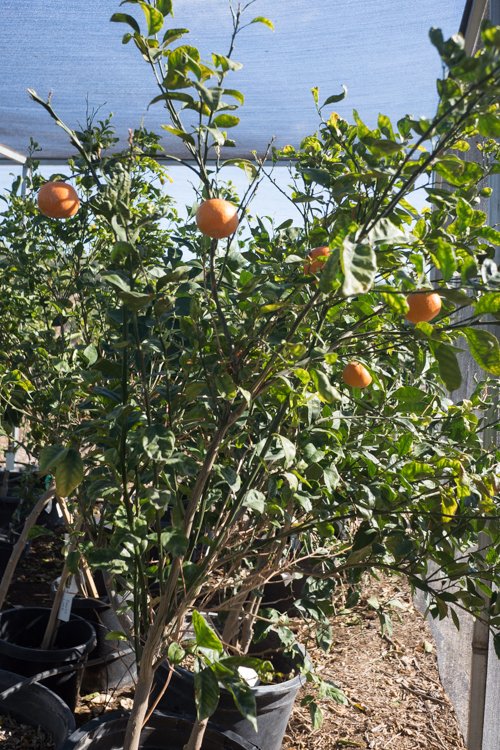Tangerine Tree
The tangerine tree is one of the most rewarding trees to grow.
It’s beautiful and fragrant, and of course, it produces tangerines! Once the tangerine ripens on the tree, you can peel it open immediately to eat it or take it as a snack.
It’s also a small to medium-sized tree that does well in containers, which makes it easy to manage.
Botanical name: Citrus reticulata
Other names: Mandarin tree
Tangerine tree for sale at our nursery
TABLE OF CONTENTS
Tangerine tree Appearance
Tangerine trees are evergreen trees with glossy green leaves year-round. Oval-shaped leaves with pointy tips.
It grows to 15-20 feet tall and 5-10 feet wide, although many people keep it shorter for easier maintenance and harvest—the rounded shape and dense canopy.
Small, white flowers grow in clusters at the end of branches and have a robust and pleasant fragrance.
Followed by small citrus fruit, about 3 inches in diameter. Tangerines are orange and have thick skin that is easy to peel and transport. The flesh is juicy, sweet, and slightly sour.
Tangerine tree Landscaping Tips
Good small to medium ornamental tree for patios.
Keep it in a container and overwinter indoors if your region experiences below-freezing temperatures.
Tangerines make easily portable snacks. It also makes good fruit juice like oranges.
Great tree for adding fragrance to the garden and attracting pollinators such as birds, bees, and butterflies.
Tangerine tree Origin
Tangerine trees are believed to be from China.
Tangerine tree Care
Soil: Fertile, well-draining soil that is slightly acidic to acidic. Use a fertilizer formulated for citrus trees.
Temperature: Can withstand temperatures down to frost for a short period of time. If you live in a climate that experiences cold winters, we recommend overwintering them indoors.
Water: Moderate water needs. Regular deep watering, especially when blooming and fruiting and during heat waves.
Sun: Full sun
Tangerine tree Problems
Tangerine tree with ripe tangerines on branches
Pests: Tangerine trees may attract pests such as aphids, mealybugs, and scale.
For aphids, blast them off with water if the infestation is light. Otherwise, use horticultural oil or soapy water.
To remove mealybugs, use insecticidal soap or apply rubbing alcohol directly to the area of the infestation using a cotton swab.
To remove scales, pick them off or use horticultural oil or insecticidal soap. Horticultural oil will kill both crawlers and adults with direct contact. Insecticidal soap is better used to target only the crawlers.
Whenever using any pesticide, be aware that it can damage the plant if the temperatures are in the 80s or above.
Signs of overwatering: Root rot, drooping leaves
Signs of too little water: Browning and drying leaves
Signs of too much sun: Leaf burn, fading color
Signs of too little sun: Etiolation, stunted growth, few flowers
Tangerine tree Propagation
The easiest way to propagate a tangerine tree is through cuttings. Obtain 1-foot-long semi-hardwood cuttings with a sharp tool and plant them in the soil. Keep soil moist until it's well established.
FAQ
HOW MUCH DOES a tangerine Tree COST?
At our nursery, tangerine trees cost $150 for a 15-gallon container and $325 for a 24” box.
Prices are subject to change. Please get in touch with us for the most up-to-date pricing information. We may have larger sizes available. We provide installation services locally at a separate cost.
When is the best time to fertilize tangerine trees?
Tangerine trees should be fertilized in the early spring, just before new growth begins. We recommend using a fertilizer formulated for citrus trees or fruit trees.
How do I know if my tangerine tree is ready to harvest?
Tangerines are usually ready to harvest in the fall or winter. The fruit should be bright orange and soft. A gentle tug should release the fruit from the tree.
Summary
| SIZE (H X W) | 15 feet X 10 feet |
|---|---|
| FLOWER COLOR | White |
| FLOWER SEASON | Spring |
| EXPOSURE | Full Sun |
| WATER | Moderate |
| GROWTH RATE | Moderate |
| HARDINESS | 25º F, USDA Zone 9 |
| PRUNING | As needed |

